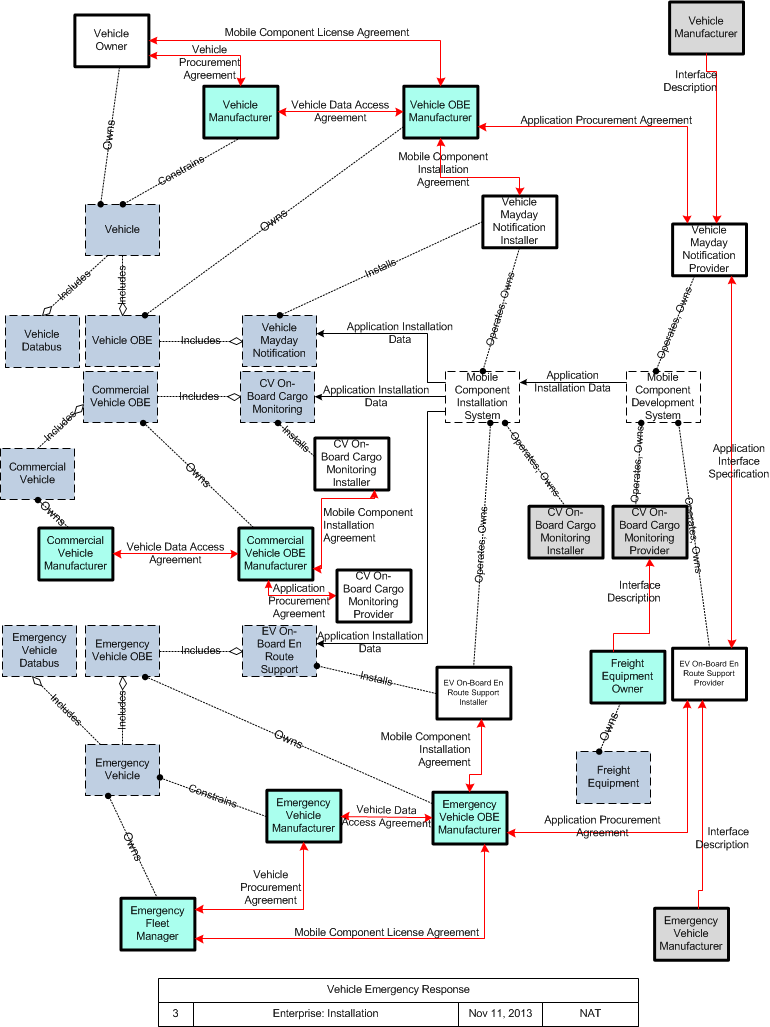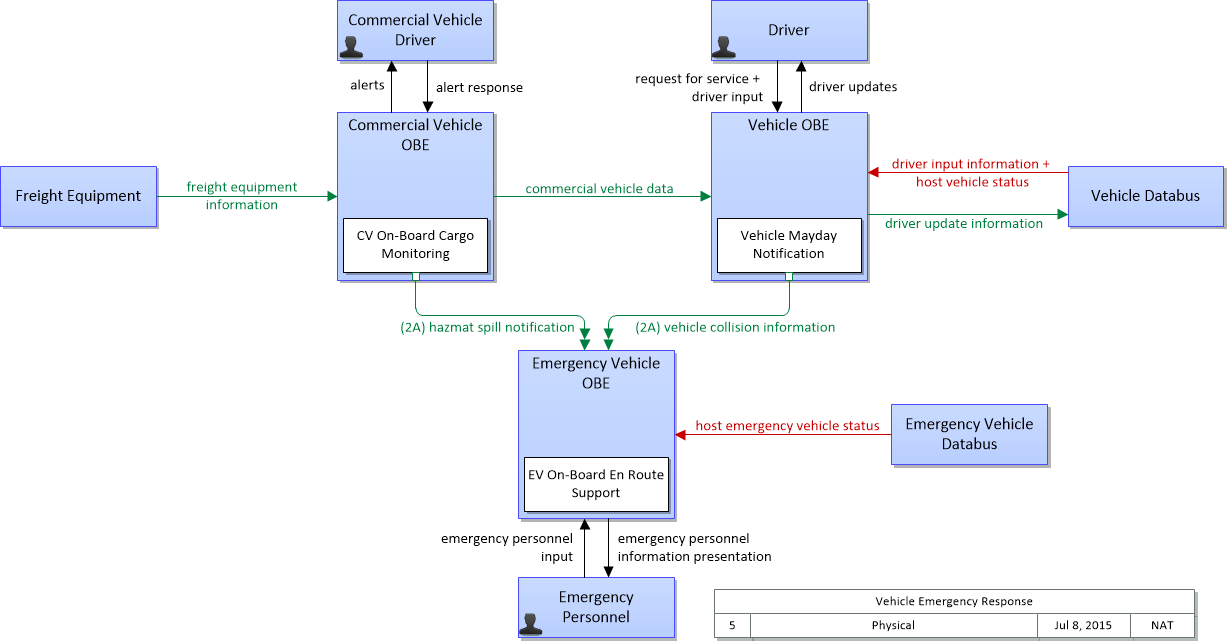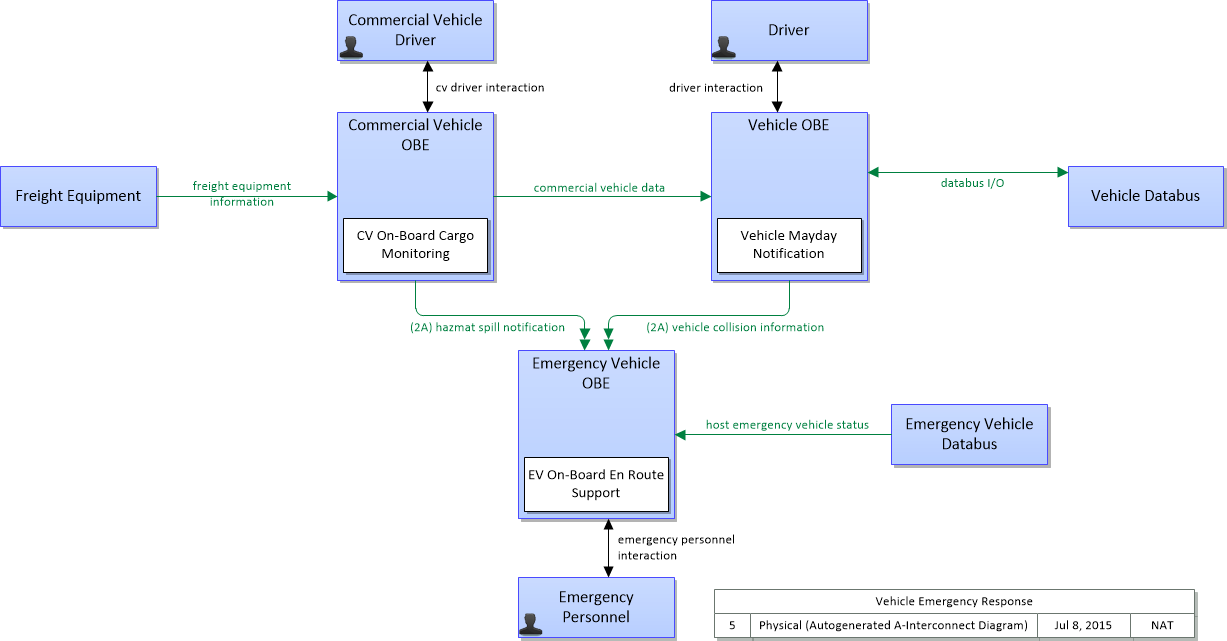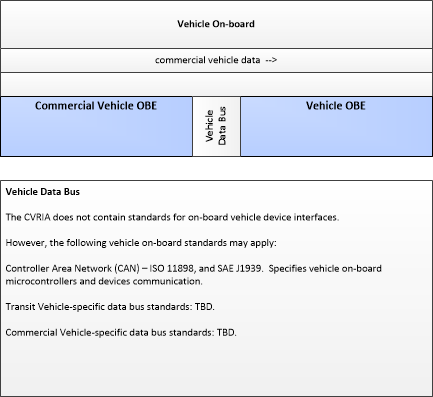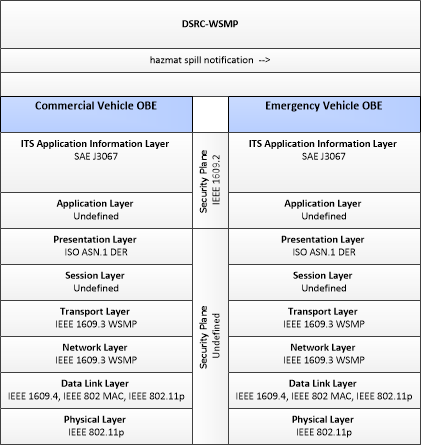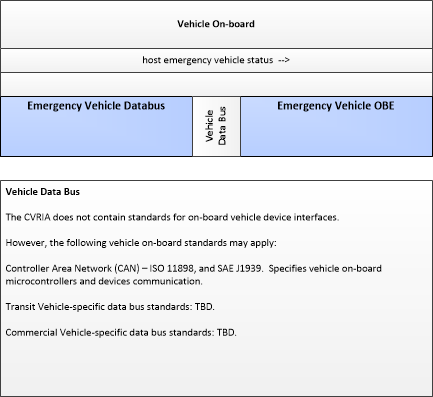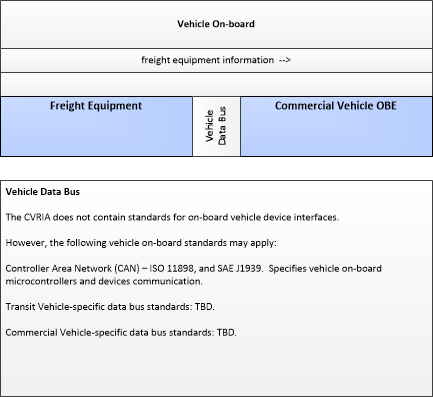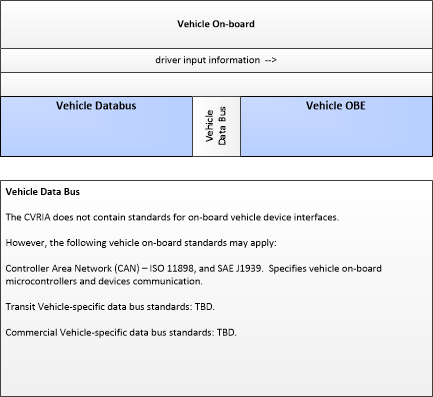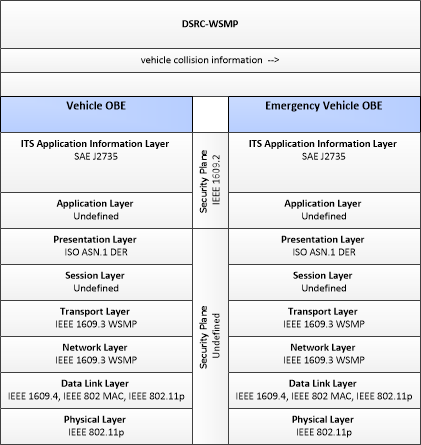Type: Safety
Groups:- V2V Safety
Vehicle Emergency Response
The Vehicle Emergency Response (VER) application provides public safety vehicles with information from connected vehicles involved in a crash. Emergency responders need information about the vehicles involved in a crash to respond safely and effectively to the vehicle crash. Information such as HAZMAT data can assist the responders on-board the responding public safety vehicle to prepare. Information about air bag activations can provide useful input to ambulance staff. In addition information about the power system of the vehicle (e.g. hybrid, electric, or internal combustion engine) can affect the response.
Enterprise
SVG Diagrams: Installation Operations Maintenance Certification
PNG Diagrams: Installation Operations Maintenance Certification

Business Interaction Matrix:
| Vehicle Emergency Response Operations Stage | ||||||||||||
|---|---|---|---|---|---|---|---|---|---|---|---|---|
| Vehicle Owner | Driver | Vehicle OBE Owner | Commercial Vehicle Owner | Commercial Vehicle Manufacturer | Freight Equipment Owner | Commercial Vehicle Driver | Emergency Vehicle Manager | Emergency Personnel | EV On-Board En Route Support Provider | Commercial Vehicle OBE Manufacturer | Vehicle Mayday Notification Provider | |
| Vehicle Owner | Vehicle Usage Agreement | Vehicle OBE Usage Agreement | Application Usage Agreement | |||||||||
| Driver | Vehicle Usage Agreement | Expectation of Information Provision | ||||||||||
| Vehicle OBE Owner | Vehicle OBE Usage Agreement | Expectation of Information Provision | Expectation of Information Provision | Expectation of Information Provision | ||||||||
| Commercial Vehicle Owner | Vehicle Procurement Agreement | Expectation of Information Provision | ||||||||||
| Commercial Vehicle Manufacturer | Vehicle Procurement Agreement | Vehicle Data Access Agreement | ||||||||||
| Freight Equipment Owner | Expectation of Information Provision | |||||||||||
| Commercial Vehicle Driver | Expectation of Information Provision | Expectation of Information Provision | Expectation of Information Provision | Expectation of Information Provision | ||||||||
| Emergency Vehicle Manager | Vehicle Operating Agreement | Application Usage Agreement | ||||||||||
| Emergency Personnel | Expectation of Information Provision | Expectation of Information Provision | Vehicle Operating Agreement | |||||||||
| EV On-Board En Route Support Provider | Application Usage Agreement | |||||||||||
| Commercial Vehicle OBE Manufacturer | Vehicle Data Access Agreement | |||||||||||
| Vehicle Mayday Notification Provider | Application Usage Agreement | |||||||||||
Includes Enterprise Objects:
| Enterprise Object | Description |
|---|---|
| Application Certification Entity | The body that determines whether an application may be deployed and operated in the Connected Vehicle Environment. This entity's composition, the requirements it applies and the procedures it uses to verify those requirements may vary with application type. For example, applications with human safety component (crash avoidance, movement assistance etc.) may have stringent requirements and extensive testing in a variety of conditions, while applications that provide strictly mobility functionality may have far less testing requirements; possibly as little as just making sure the application doesn't interfere with any other applications. |
| Commercial Vehicle Driver | The 'Commercial Vehicle Driver' represents the people that operate vehicles transporting goods, including both long haul trucks and local pick-up and delivery vans. This physical object is complementary to the Driver physical object in that it represents those interactions which are unique to Commercial Vehicle Operations. Information flowing from the Commercial Vehicle Driver includes those system inputs specific to Commercial Vehicle Operations. |
| Commercial Vehicle Manufacturer | The entity which builds commercial vehicles, including long haul trucks and local pick up and delivery vehicles. This entity is complementary to the Vehicle Manufacturer entity in that it represents those aspects of vehicle manufacture which are unique to commercial vehicles. |
| Commercial Vehicle OBE Manufacturer | The Commercial Vehicle OBE Manufacturer is the provider of the commercial vehicle on-board equipment. This entity may design and build the OBE, or may integrate other components to form the OBE, or may use some combination of approaches to provide the on-board equipment. Since the OBE could be aftermarket, retrofit, built-in or nomadic, this entity is the one that builds whatever that-is. In some cases it may be a smart phone manufacturer, or in others a top tier parts supplier, or any other entity in the production chain, depending on the device and commercial vehicle in question. |
| Commercial Vehicle Owner | The entity that owns the commercial vehicle. This entity is complementary to the Vehicle Owner in that it represents those aspects of ownership which are unique to commercial vehicles. |
| CV On-Board Cargo Monitoring Installer | Application Component Installers are specified more by role than by function. Installers are responsible for the installation of the application component, which may require a support system, and may entail agreements and relationships between end users and application providers. |
| CV On-Board Cargo Monitoring Maintainer | Application Component Maintainers are specified more by role than by function. Maintainers are responsible for the maintenance (configuration changes, patches and updates, hardware repairs) of the application component, which may require a support system, and may entail agreements and relationships between end users and application providers. |
| CV On-Board Cargo Monitoring Provider | Application Component Providers are specified more by role than by function. Providers are responsible for the development of the application component, including initial creation, enhancement and bug fixes. Delivery of the application to the end user may require relationships with other entities (installers, maintainers) if the provider chooses not to fulfill those roles. |
| Device Certification Entity | The body that determines whether a device may be deployed and operated in the Connected Vehicle Environment. This entity's composition, the requirements it applies and the procedures it uses to verify those requirements may vary with device type. |
| Driver | The 'Driver' represents the person that operates a vehicle on the roadway. Included are operators of private, transit, commercial, and emergency vehicles where the interactions are not particular to the type of vehicle (e.g., interactions supporting vehicle safety applications). The Driver originates driver requests and receives driver information that reflects the interactions which might be useful to all drivers, regardless of vehicle classification. Information and interactions which are unique to drivers of a specific vehicle type (e.g., fleet interactions with transit, commercial, or emergency vehicle drivers) are covered by separate objects. |
| Emergency Fleet Manager | The entity that controls emergency vehicles and provides them for use in incident response. |
| Emergency Personnel | 'Emergency Personnel' represents personnel that are responsible for police, fire, emergency medical services, towing, service patrols, and other special response team (e.g., hazardous material clean-up) activities at an incident site. These personnel are associated with the Emergency Vehicle during dispatch to the incident site, but often work independently of the Emergency Vehicle while providing their incident response services. |
| Emergency Vehicle Manager | The enterprise that controls and manages emergency vehicle operations. |
| Emergency Vehicle Manufacturer | The entity that builds, assembles, verifies and validates the Emergency Vehicle in which the Emergency Vehicle OBE will eventually operate. |
| Emergency Vehicle OBE Manufacturer | The entity that builds, assembles, verifies and validates the Emergency Vehicle OBE. This can be an OEM-equipped OBE, retrofit or aftermarket equipment. |
| EV On-Board En Route Support Installer | Application Component Installers are specified more by role than by function. Installers are responsible for the installation of the application component, which may require a support system, and may entail agreements and relationships between end users and application providers. |
| EV On-Board En Route Support Maintainer | Application Component Maintainers are specified more by role than by function. Maintainers are responsible for the maintenance (configuration changes, patches and updates, hardware repairs) of the application component, which may require a support system, and may entail agreements and relationships between end users and application providers. |
| EV On-Board En Route Support Provider | Application Component Providers are specified more by role than by function. Providers are responsible for the development of the application component, including initial creation, enhancement and bug fixes. Delivery of the application to the end user may require relationships with other entities (installers, maintainers) if the provider chooses not to fulfill those roles. |
| Federal Regulatory | Federal regulatory bodies that have legal authority to control and/or provide input to policies regulating transportation infrastructure and operations. This includes entities such as the Federal Communications Commission and US Department of Transportation. |
| Freight Equipment Owner | The entity that owns freight equipment such as a freight container, intermodal chassis or trailer. |
| State Regulatory | State regulatory bodies that have legal authority to control and/or provide input to policies regulating vehicles, transportation infrastructure and operations. This includes entities like Departments of Motor Vehicles, property tax authorities and tolling agencies. |
| Vehicle Manufacturer | The entity that builds, assembles, verifies and validates the Vehicle in which the Vehicle OBE will eventually operate. |
| Vehicle Mayday Notification Installer | Application Component Installers are specified more by role than by function. Installers are responsible for the installation of the application component, which may require a support system, and may entail agreements and relationships between end users and application providers. |
| Vehicle Mayday Notification Maintainer | Application Component Maintainers are specified more by role than by function. Maintainers are responsible for the maintenance (configuration changes, patches and updates, hardware repairs) of the application component, which may require a support system, and may entail agreements and relationships between end users and application providers. |
| Vehicle Mayday Notification Provider | Application Component Providers are specified more by role than by function. Providers are responsible for the development of the application component, including initial creation, enhancement and bug fixes. Delivery of the application to the end user may require relationships with other entities (installers, maintainers) if the provider chooses not to fulfill those roles. |
| Vehicle OBE Manufacturer | The entity that builds, assembles, verifies and validates the Vehicle OBE. This can be an OEM-equipped OBE, retrofit or aftermarket equipment. |
| Vehicle OBE Owner | The entity, individual, group or corporation that owns the Vehicle On-Board equipment. This could be the same as the Vehicle Owner, but it could be a third part that licenses the use of the OBE to the Owner. |
| Vehicle Owner | The individual, group of individuals or corporate entity that is identified as the registered owner of the Vehicle under state law. |
Includes Resources:
| Resource | Description |
|---|---|
| Application Component Certification Requirements | The requirements that define the functionality, performance and operational environment of an application component. Certification Requirements must be met in order for an application to be installed in the CVE. |
| Commercial Vehicle | The commercial vehicle includes the sensory, processing, storage, and communications functions necessary to support safe and efficient commercial vehicle operations. It includes two-way communications between the commercial vehicle drivers, their fleet managers, attached freight equipment, and roadside officials, and provides HAZMAT response teams with timely and accurate cargo contents information after a vehicle incident. It can collect and process vehicle, cargo information from the attached freight equipment, and driver safety data and status and alert the driver whenever there is a potential safety or security problem. Basic identification, security and safety status data are supplied to inspection facilities at mainline speeds. In addition, it can automatically collect and record mileage, fuel usage, and border crossings. |
| Commercial Vehicle OBE | The Commercial Vehicle On-Board Equipment (OBE) resides in a commercial vehicle and provides the sensory, processing, storage, and communications functions necessary to support safe and efficient commercial vehicle operations. It provides two-way communications between the commercial vehicle drivers, their fleet managers, attached freight equipment, and roadside officials. In CVRIA, a separate 'Vehicle OBE' physical object supports the general V2V and V2I safety applications and other applications that apply to all vehicles, including commercial vehicles. The Commercial Vehicle OBE supplements these general capabilities with capabilities that are specific to commercial vehicles. |
| CV On-Board Cargo Monitoring | "CV On-Board Cargo Monitoring" monitors the location and status of the commercial vehicle and its cargo. It sends the collected data to appropriate centers and roadside facilities, including emergency management in the case of HAZMAT incidents. Depending on the nature of the cargo, it may include sensors that measure temperature, pressure, load leveling, acceleration, and other attributes of the cargo. |
| Device Certification Requirements | The requirements that define the functionality, performance and operational environment of a connected vehicle device. Certification Requirements must be met in order for the device to be granted the credentials necessary to operate in the Connected Vehicle Environment. |
| Emergency Vehicle | The "Emergency Vehicle" represents a range of vehicles including those operated by police, fire, and emergency medical services, as well as incident response vehicles including towing and recovery vehicles and freeway service patrols. |
| Emergency Vehicle Databus | The 'Emergency Vehicle Databus' represents the vehicle databus that interfaces with on-board equipment on a public safety vehicle. It is a specialized and extended form of the Vehicle Databus that may be subject to different vehicle databus standards and hosts a broad range of components that are specific to emergency vehicles including the lightbar/siren and on-board apparatus that supports law enforcement, firefighting, and emergency medical services. As a specialized form of the Vehicle Databus, it also provides access to the general-purpose sensors (e.g., radars, cameras), GPS, drive train monitoring and control systems, and vehicle safety features that support connected vehicle applications. In CVRIA, the 'Emergency Vehicle Databus' is used to represent the onboard interactions between the Emergency Vehicle OBE and the other systems included in a host emergency vehicle. |
| Emergency Vehicle OBE | The Emergency Vehicle On-Board Equipment (OBE) resides in an emergency vehicle and provides the processing, storage, and communications functions that support public safety-related connected vehicle applications. It represents a range of vehicles including those operated by police, fire, and emergency medical services. In addition, it represents other incident response vehicles including towing and recovery vehicles and freeway service patrols. It includes two-way communications to support coordinated response to emergencies. In CVRIA, a separate 'Vehicle OBE' physical object supports the general V2V and V2I safety applications and other applications that apply to all vehicles, including emergency vehicles. The Emergency Vehicle OBE supplements these general capabilities with capabilities that are specific to emergency vehicles. |
| EV On-Board En Route Support | "EV On-board En Route Support" provides communications functions to responding emergency vehicles that reduce response times and improve safety of responding public safety personnel and the general public. It supports traffic signal preemption via short range communication directly with signal control equipment and sends alert messages to surrounding vehicles. |
| Freight Equipment | 'Freight Equipment' represents a freight container, intermodal chassis, or trailer and provides sensory, processing, storage, and communications functions necessary to support safe, secure and efficient freight operations. It provides equipment safety data and status and can alert the appropriate systems of an incident, breach, or tamper event. It also provides accurate position information to support in-transit visibility of freight equipment. |
| Mobile Component Development System | The system used in a backoffice environment to develop and test the mobile component of the application. |
| Mobile Component Installation System | The system that interacts with the Vehicle OBE other mobile device and installs the mobile component of the application. |
| Mobile Component Maintenance System | The system used to configure changes and updates to the mobile component of the application. This system is capable of acquiring and reporting diagnostic information about the application's configuration and performance. |
| Vehicle | The conveyance that provides the sensory, processing, storage, and communications functions necessary to support efficient, safe, and convenient travel. These functions reside in general vehicles including personal automobiles, commercial vehicles, emergency vehicles, transit vehicles, or other vehicle types. |
| Vehicle Databus | The 'Vehicle Databus' represents the interface to the vehicle databus (e.g., CAN, LIN, Ethernet/IP, FlexRay, and MOST) that may enable communication between the Vehicle OBE and other vehicle systems to support connected vehicle applications. The vehicle system statuses and/or sensor outputs available on the databus will vary based on the equipment installed on the vehicle and availability on databus. System statuses and sensor outputs may include select vehicle systems and sensors such as accelerometers, yaw rate sensors, and GPS derived location and timing information. In CVRIA, this physical object is used to represent the onboard interactions between the Vehicle OBE and the other systems included in a host vehicle. Note that the vehicle databus interface is not standardized across all vehicle classes. Also, some Vehicle OBE implementations will not have access to the vehicle databus. See 'Vehicle OBE' for more information. |
| Vehicle Mayday Notification | "Vehicle Mayday Notification" provides the capability for drivers or collision detection sensors to report an emergency and summon assistance. It gathers data from on-board collision detection sensors, provides a mechanism for the driver to summon assistance, and includes a communications capability to report the collision including indicators of collision severity, the number of passengers involved, and information about the vehicle that may affect the response. |
| Vehicle OBE | The Vehicle On-Board Equipment (OBE) provides the vehicle-based processing, storage, and communications functions necessary to support connected vehicle operations. The radio(s) supporting V2V and V2I communications are a key component of the Vehicle OBE. This communication platform is augmented with processing and data storage capability that supports the connected vehicle applications. In CVRIA, the Vehicle OBE includes the functions and interfaces that support connected vehicle applications for passenger cars, trucks, and motorcycles. Many of these applications (e.g., V2V Safety applications) apply to all vehicle types including personal vehicles, commercial vehicles, emergency vehicles, transit vehicles, and maintenance vehicles. From this perspective, the Vehicle OBE includes the common interfaces and functions that apply to all motorized vehicles. |
Includes Roles:
| Role | Description |
|---|---|
| Certifies | An Enterprise verifies that a target Resource meets relevant performance, functional, environmental and quality requirements. |
| Constrains | A Resource or Enterprise applies requirements, constraints and associated tests to another Resource. |
| Installs | An Enterprise performs the initial delivery, integration and configuration of the target Resource. |
| Maintains | An Enterprise administers the hardware and software that comprise the target Resource. |
| Member | An Enterprise is part of another larger, target Enterprise. |
| Operates | An Enterprise controls the functionality and state of the target Resource. An Enterprise that Operates a resource is considered Responsible. |
| Owns | An Enterprise has financial ownership and control over the Resource. An Enterprise that Owns a resource is considered Accountable. |
Includes Coordination:
| Coordination | Type | Description |
|---|---|---|
| Application Installation Data | Information Sharing | Data needed to install the application, including the application executable code and any configuration data. Unidirectional flow. |
| Application Interface Specification | Agreement | The definition of an interface between two application components that operate on two distinct pieces of hardware. The Application Interface Specification is specific to the application in question. |
| Application Maintenance Data | Information Sharing | Data used to facilitate the upgrade, patching and general health maintenance of an application component. |
| Application Performance Data | Information Sharing | Data used to characterize application performance, including such measures as availability, known errors and known uses. |
| Application Procurement Agreement | Agreement | An agreement whereupon one entity provides a copy of an application component to another entity. This component is capable of being installed and functioning, according to its requirements that passed through the application's certification process. |
| Application Usage Agreement | Agreement | An agreement in which one entity that controls an application component's use gives the other entity the necessary tools and permission to operate that application or application component. |
| Expectation of Information Provision | Expectation | An expectation where one party believes another party will provide it information whenever such information is likely relevant to the recipient. |
| Includes | Includes | Indicates that one component is entirely contained within another component. |
| Interface Description | Agreement | Documentation of the interface between two systems, where one system does not have an application component that is part of the application, but does provide and/or receive data and/or information that is used by or sourced from the application. In many cases this is an existing interface used by the application, so the description of the interface already exists and is imposed by the terminator. |
| Maintenance Data Exchange Agreement | Agreement | An agreement that states one entity will provide data related to maintenance of an application component to the other entity. |
| Mobile Component Installation Agreement | Agreement | An agreement whereupon the controller of OBE gives another party permission to install, configure and make operational a component that enables the mobile portion of an application. |
| Mobile Component License Agreement | Agreement | An end-user license agreement allowing the operator of the mobile device to use the mobile application component that is part of the application in question. |
| Mobile Component Maintenance Agreement | Agreement | An agreement in which one entity maintains the operational status of the mobile component of an application under the control of another entity. This maintenance may include routine and as-needed maintenance, such as software update and configuration, hardware replacement and related system administration activities. |
| Vehicle Data Access Agreement | Agreement | An agreement whereby the party that controls access to on-board vehicle data grants another party the right and ability to access that data. Includes the conditions under which data may be accessed, and specifies the mechanisms, including physical and functional access methods, data formats and any other considerations necessary for the accessing party to acquire data. May also include caveats regarding responsibility for data quality and responsibility for use of the data. |
| Vehicle OBE Usage Agreement | Agreement | An agreement that grants one entity permission to use a Vehicle OBE that the other party controls. |
| Vehicle Operating Agreement | Agreement | An agreement whereupon the controller of a vehicle grants another entity permission and rights to operate the vehicle. |
| Vehicle Procurement Agreement | Agreement | The exchange of a vehicle for compensation. One entity purchases the vehicle from the other. |
| Vehicle Usage Agreement | Agreement | An agreement between the owner of a vehicle and a prospective operator, whereupon the owner allows the operator to use the vehicle. |
| Warranty | Agreement | A guarantee or promise made by one entity to another, that provides assurance of the functionality and performance over time of an application component. |
Functional
Includes Processes:
| Level | Name | Type | Allocated to Application Object |
|---|---|---|---|
| 2.4 | Provide Commercial Vehicle Data Collection | Collection | |
| 2.4.4 | Provide Commercial Vehicle Driver Interface | Pspec |
- CV On-Board Cargo Monitoring |
| 3.1 | Monitor Vehicle Status | Collection | |
| 3.1.3 | Process Vehicle On-board Data | Pspec |
- Vehicle Mayday Notification |
| 3.3 | Provide Automatic Emergency Notification | Collection | |
| 3.3.1 | Provide Communications Function | Pspec |
- Vehicle Mayday Notification |
| 3.3.2 | Build Automatic Collision Notification Message | Pspec |
- Vehicle Mayday Notification |
| 5.3 | Manage Emergency Vehicles | Collection | |
| 5.3.3 | Provide Emergency Vehicle Location | Pspec |
- EV On-Board En Route Support |
| 5.3.5 | Provide Emergency Personnel Interface | Pspec |
- EV On-Board En Route Support |
| 5.3.9 | Process Mobile Emergency Requests | Pspec |
- EV On-Board En Route Support |
| 6.7 | Provide Driver Personal Services | Collection | |
| 6.7.1 | Provide On-line Vehicle Guidance | Collection | |
| 6.7.1.3 | Process Vehicle Location Data | Pspec |
Includes Data Flows:
Physical
SVG Diagram
PNG Diagram

Includes Physical Objects:
| Physical Object | Class | Description |
|---|---|---|
| Commercial Vehicle Driver | Vehicle | The 'Commercial Vehicle Driver' represents the people that operate vehicles transporting goods, including both long haul trucks and local pick-up and delivery vans. This physical object is complementary to the Driver physical object in that it represents those interactions which are unique to Commercial Vehicle Operations. Information flowing from the Commercial Vehicle Driver includes those system inputs specific to Commercial Vehicle Operations. |
| Commercial Vehicle OBE | Vehicle | The Commercial Vehicle On-Board Equipment (OBE) resides in a commercial vehicle and provides the sensory, processing, storage, and communications functions necessary to support safe and efficient commercial vehicle operations. It provides two-way communications between the commercial vehicle drivers, their fleet managers, attached freight equipment, and roadside officials. In CVRIA, a separate 'Vehicle OBE' physical object supports the general V2V and V2I safety applications and other applications that apply to all vehicles, including commercial vehicles. The Commercial Vehicle OBE supplements these general capabilities with capabilities that are specific to commercial vehicles. |
| Driver | Vehicle | The 'Driver' represents the person that operates a vehicle on the roadway. Included are operators of private, transit, commercial, and emergency vehicles where the interactions are not particular to the type of vehicle (e.g., interactions supporting vehicle safety applications). The Driver originates driver requests and receives driver information that reflects the interactions which might be useful to all drivers, regardless of vehicle classification. Information and interactions which are unique to drivers of a specific vehicle type (e.g., fleet interactions with transit, commercial, or emergency vehicle drivers) are covered by separate objects. |
| Emergency Personnel | Vehicle | 'Emergency Personnel' represents personnel that are responsible for police, fire, emergency medical services, towing, service patrols, and other special response team (e.g., hazardous material clean-up) activities at an incident site. These personnel are associated with the Emergency Vehicle during dispatch to the incident site, but often work independently of the Emergency Vehicle while providing their incident response services. |
| Emergency Vehicle Databus | Vehicle | The 'Emergency Vehicle Databus' represents the vehicle databus that interfaces with on-board equipment on a public safety vehicle. It is a specialized and extended form of the Vehicle Databus that may be subject to different vehicle databus standards and hosts a broad range of components that are specific to emergency vehicles including the lightbar/siren and on-board apparatus that supports law enforcement, firefighting, and emergency medical services. As a specialized form of the Vehicle Databus, it also provides access to the general-purpose sensors (e.g., radars, cameras), GPS, drive train monitoring and control systems, and vehicle safety features that support connected vehicle applications. In CVRIA, the 'Emergency Vehicle Databus' is used to represent the onboard interactions between the Emergency Vehicle OBE and the other systems included in a host emergency vehicle. |
| Emergency Vehicle OBE | Vehicle | The Emergency Vehicle On-Board Equipment (OBE) resides in an emergency vehicle and provides the processing, storage, and communications functions that support public safety-related connected vehicle applications. It represents a range of vehicles including those operated by police, fire, and emergency medical services. In addition, it represents other incident response vehicles including towing and recovery vehicles and freeway service patrols. It includes two-way communications to support coordinated response to emergencies. In CVRIA, a separate 'Vehicle OBE' physical object supports the general V2V and V2I safety applications and other applications that apply to all vehicles, including emergency vehicles. The Emergency Vehicle OBE supplements these general capabilities with capabilities that are specific to emergency vehicles. |
| Freight Equipment | Vehicle | 'Freight Equipment' represents a freight container, intermodal chassis, or trailer and provides sensory, processing, storage, and communications functions necessary to support safe, secure and efficient freight operations. It provides equipment safety data and status and can alert the appropriate systems of an incident, breach, or tamper event. It also provides accurate position information to support in-transit visibility of freight equipment. |
| Vehicle Databus | Vehicle | The 'Vehicle Databus' represents the interface to the vehicle databus (e.g., CAN, LIN, Ethernet/IP, FlexRay, and MOST) that may enable communication between the Vehicle OBE and other vehicle systems to support connected vehicle applications. The vehicle system statuses and/or sensor outputs available on the databus will vary based on the equipment installed on the vehicle and availability on databus. System statuses and sensor outputs may include select vehicle systems and sensors such as accelerometers, yaw rate sensors, and GPS derived location and timing information. In CVRIA, this physical object is used to represent the onboard interactions between the Vehicle OBE and the other systems included in a host vehicle. Note that the vehicle databus interface is not standardized across all vehicle classes. Also, some Vehicle OBE implementations will not have access to the vehicle databus. See 'Vehicle OBE' for more information. |
| Vehicle OBE | Vehicle | The Vehicle On-Board Equipment (OBE) provides the vehicle-based processing, storage, and communications functions necessary to support connected vehicle operations. The radio(s) supporting V2V and V2I communications are a key component of the Vehicle OBE. This communication platform is augmented with processing and data storage capability that supports the connected vehicle applications. In CVRIA, the Vehicle OBE includes the functions and interfaces that support connected vehicle applications for passenger cars, trucks, and motorcycles. Many of these applications (e.g., V2V Safety applications) apply to all vehicle types including personal vehicles, commercial vehicles, emergency vehicles, transit vehicles, and maintenance vehicles. From this perspective, the Vehicle OBE includes the common interfaces and functions that apply to all motorized vehicles. |
Includes Application Objects:
| Application Object | Description | Physical Object |
|---|---|---|
| CV On-Board Cargo Monitoring | "CV On-Board Cargo Monitoring" monitors the location and status of the commercial vehicle and its cargo. It sends the collected data to appropriate centers and roadside facilities, including emergency management in the case of HAZMAT incidents. Depending on the nature of the cargo, it may include sensors that measure temperature, pressure, load leveling, acceleration, and other attributes of the cargo. | Commercial Vehicle OBE |
| EV On-Board En Route Support | "EV On-Board En Route Support" provides communications functions to responding emergency vehicles that reduce response times and improve safety of responding public safety personnel and the general public. It supports traffic signal preemption via short range communication directly with signal control equipment and sends alert messages to surrounding vehicles. | Emergency Vehicle OBE |
| Vehicle Mayday Notification | "Vehicle Mayday Notification" provides the capability for drivers or collision detection sensors to report an emergency and summon assistance. It gathers data from on-board collision detection sensors, provides a mechanism for the driver to summon assistance, and includes a communications capability to report the collision including indicators of collision severity, the number of passengers involved, and information about the vehicle that may affect the response. | Vehicle OBE |
Includes Information Flows:
| Information Flow | Description |
|---|---|
| alert response | This flow represents the tactile or auditory interface with ITS equipment. It contains the response by a Commercial Vehicle Driver or Fleet-Freight Manager that confirms or cancels an alert. |
| alerts | This flow represents the visual or auditory interface with ITS equipment containing specific alerts and messages related to commercial vehicles (e.g. trucks not advised, trucks over 10 tons not allowed on bridge, route details). This also includes detected route deviations and warning indications detected by on-board sensors (e.g., safety) and freight equipment sensors (e.g., breach, cargo). |
| commercial vehicle data | Information about the commercial vehicles cargo, credentials, and payments that is shared between on board equipment over an in-vehicle bus. This includes freight equipment type (box, flatbed, trailer, container, etc.), type of cargo (refrigerated, non-perishable, liquid, etc.), hazardous material data, quantity of cargo, and cargo permits as applicable (hazmat, special routing permissions). |
| driver input | Driver input to the vehicle on-board equipment including configuration data, settings and preferences, interactive requests, and control commands. |
| driver input information | Driver input received from the driver-vehicle interface equipment via the vehicle bus. It includes configuration data, settings and preferences, interactive requests, and control commands for the connected vehicle on-board equipment. |
| driver update information | Information provided to the driver-vehicle interface to inform the driver about current conditions, potential hazards, and the current status of vehicle on-board equipment. The flow includes the information to be presented to the driver and associated metadata that supports processing, prioritization, and presentation by the DVI as visual displays, audible information and warnings, and/or haptic feedback. |
| driver updates | Information provided to the driver including visual displays, audible information and warnings, and haptic feedback. The updates inform the driver about current conditions, potential hazards, and the current status of vehicle on-board equipment. |
| emergency personnel information presentation | Presentation of information to emergency personnel in the field including dispatch information, incident information, current road network conditions, device status, and other supporting information. |
| emergency personnel input | User input from emergency personnel in the field including dispatch coordination, incident status information, and remote device control requests. |
| freight equipment information | Container, trailer, or chassis information regarding identity, type, location, brake wear data, mileage, seal #, seal type, door open/close status, chassis bare/covered status, tethered / untethered status, temperature, humidity, power, battery levels, brake wear data, and bill of lading/information regarding the cargo/content. |
| hazmat spill notification | Information provided to emergency response organizations when cargo sensors detect a release of hazardous material. This information will include sensor information, vehicle location and identification, and carrier identification. |
| host emergency vehicle status | Information provided to the Connected Vehicle on-board equipment from other systems on the Emergency Vehicle Platform. |
| host vehicle status | Information provided to the connected vehicle on-board equipment from other systems on the vehicle platform. This includes data from on-board sensors, the current status of the powertrain, steering, and braking systems, and status of safety and convenience systems. In implementations where GPS is not integrated into the Vehicle On-Board Equipment, the host vehicle is also the source for data describing the vehicle's location in three dimensions (latitude, longitude, elevation) and accurate time that can be used for time synchronization across the Connected Vehicle environment. |
| request for service | Driver inputs that summon an emergency response, request a financial transaction, or initiate other services. |
| vehicle collision information | The current status of the vehicle systems following a collision including air bag deployment, number of passengers, seat belt usage, sensor data that indicates crash severity (e.g., Delta V speed profile during the crash, vehicle damage, number of impacts), and vehicle type/make/model. |
Application Interconnect Diagram
SVG Diagram
PNG Diagram
Application Triples
Requirements
| Need | Requirement | ||
|---|---|---|---|
| N3.109 | Vehicle to Vehicle (V2V) Safety applications need to assess their own performance, to determine errors and properly enter fail-safe mode when critical components fail. | 3.214 | Vehicle to Vehicle (V2V) Safety applications shall notify the Driver when onboard components are offline |
| 3.215 | V2V Safety applications shall notify its owner/operator when onboard components are offline. | ||
| N3.110 | V2V Safety applications need to broadcast the performance of their vehicle in the transportation environment, to enable V2V applications that rely on knowing the location and/or trajectories of other vehicles. | 3.217 | V2V Safety applications shall broadcast the vehicle type, location, speed, heading, steering angle and brake system performance of host vehicles. |
| N3.111 | V2V Safety applications need to have a common time source so that location and projected positions may be synchronized. | 3.216 | V2V Safety applications shall have a common time source. |
| N3.112 | Vehicle Emergency Response (VER) needs to collect information describing vehicles in a crash so that it can provide that information to emergency responders. | 3.218 | Vehicle Emergency Response (VER) shall collect vehicle characteristics describing the vehicles typical and real time configuration, including damage to vehicle components. |
| N3.113 | VER needs to provide information describing vehicles in a crash to emergency responders. | 3.219 | VER shall notify emergency responders of the characteristics and damage identified to the vehicle involved in a collision. |
| N3.114 | VER needs to determine that a vehicle has been involved in a crash so that it knows to provide crash information to emergency responders. | 3.220 | VER shall collect vehicle operational state information from the host vehicle. |
| 3.221 | VER shall analyze vehicle operational state information to determine if the host vehicle has been involved in a collision. | ||
Related Sources
- SAE J3067- Candidate Improvements to Dedicated Short Range Communications (DSRC) Message Set Dictionary (SAE J2735)Using Systems Engineering Methods, 8/15/2014
Security
In order to participate in this application, each physical object should meet or exceed the following security levels.
| Physical Object Security | ||||
|---|---|---|---|---|
| Physical Object | Confidentiality | Integrity | Availability | Security Class |
| Security levels have not been defined yet. | ||||
In order to participate in this application, each information flow triple should meet or exceed the following security levels.
| Information Flow Security | |||||
|---|---|---|---|---|---|
| Source | Destination | Information Flow | Confidentiality | Integrity | Availability |
| Basis | Basis | Basis | |||
| Security levels have not been defined yet. | |||||
